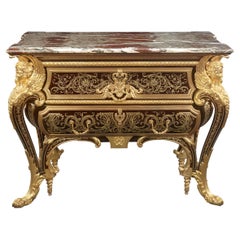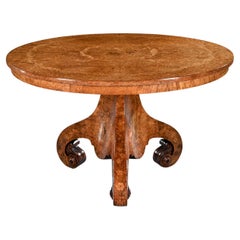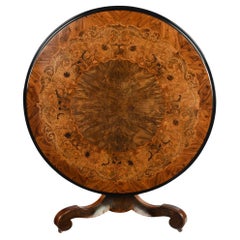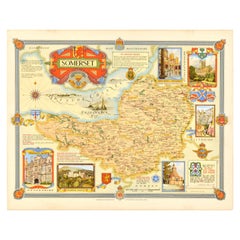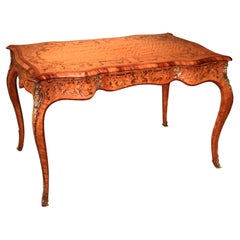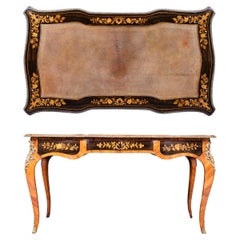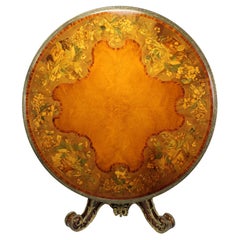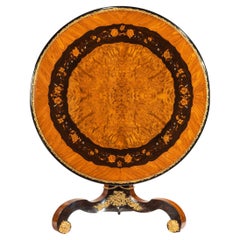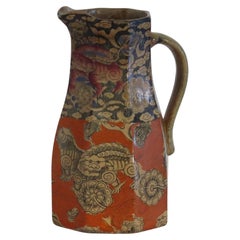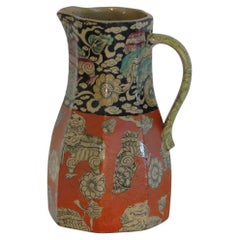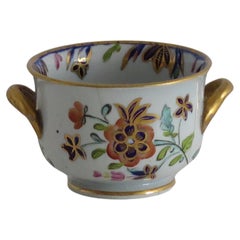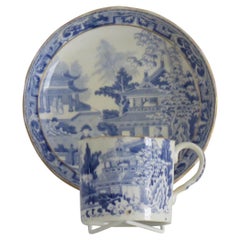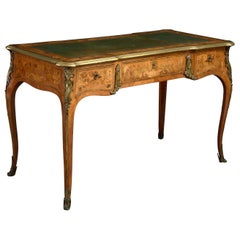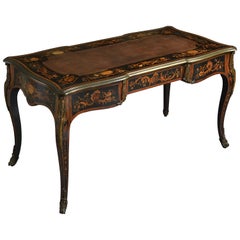Robert Blake
The Royal Boulle Marquetry Commode By Blake
By Robert Blake
Located in New Orleans, LA
This monumental Boulle commode was crafted by Robert Blake, one of the finest and most important
Category
Antique 19th Century English Louis XIV Commodes and Chests of Drawers
Materials
Bronze, Ormolu
Fine Burl Amboyna and Marquetry Centre Table Attributed to George Blake and Co a
By George Blake & Co.
Located in Benington, Herts
worked very closely to with the master of marquetry and inlay of the 19th Century Robert Blake who had
Category
Antique 1840s European Center Tables
Materials
Burl, Amboyna
$28,236
H 29 in W 46 in D 46 in
A Fine Victorian Marquetry Centre Table Attributed to Blake and Co & E. H. Baldo
By Edward Holmes Baldock
Located in Lymington, Hampshire
specialists was founded around 1820 by Robert Blake and then continued through various changes of name and
Category
Antique 19th Century English Victorian Center Tables
Materials
Wood, Kingwood, Tulipwood
$38,886
H 29.75 in W 48 in D 48 in
Original Vintage Post-World War Two Map Poster Somerset UK WWII Ernest Clegg
Located in London, GB
the region including Robert Blake (1598-1657), John Locke (1632-1704) and Henry Fielding (1707-1754
Category
Vintage 1940s British Posters
Materials
Paper
$910
H 45 in W 56 in D 0.1 in
Antique mid 19th century satinwood, marquetry, and calamander writing table
Located in London, GB
strapwork & flower garlands, supported on cabriole legs applied with gilt brass corner mounts.
Robert Blake
Category
Antique Mid-19th Century English Louis XV Desks and Writing Tables
Materials
Satinwood
$16,535
H 29 in W 46 in D 24 in
19th Century English Bureau Plat in the Manner of Edward Holmes Baldock
By Edward Holmes Baldock
Located in Dublin, IE
Tottenham Court Road inlayer and buhl manufacturer Robert Blake in the 1820s. By the 1840s the firm were
Category
Antique 19th Century English Louis XV Desks
Materials
Ormolu
$17,858
H 29.14 in W 59.45 in D 30.32 in
Victorian Marquetry Tip-Top Center Table Attributed to Edward Holmes Baldock
By Edward Holmes Baldock
Located in Los Angeles, CA
Court Road inlayer and buhl manufacturer Robert Blake in the 1820s. By the 1840s the firm were trading
Category
Antique 19th Century English Victorian Center Tables
Materials
Bronze
$124,500
H 29.25 in W 53.5 in D 53.5 in
Exceptional 19th Century Marquetry Centre Table, Edward Holmes Baldock
By Edward Holmes Baldock
Located in Benington, Herts
to with the master of marquetry and inlay of the 19th century Robert Blake whom had workshops
Category
Antique Mid-19th Century British Early Victorian Center Tables
Materials
Ebony, Maple, Tulipwood
Rare Masons Ironstone Jug or Pitcher (B) in Bandana Ptn, Exhibition mark 1851
By Mason's Ironstone
Located in Lincoln, Lincolnshire
mark is illustrated on page 125 of the book: Mason's The first Two Hundred Years by Gaye Blake Roberts
Category
Antique Mid-19th Century English Chinoiserie Pitchers
Materials
Ironstone
$595
H 7.2 in W 4.75 in D 3.75 in
Rare Masons Ironstone Jug or Pitcher (A) in Bandana Ptn, Exhibition mark 1851
By Mason's Ironstone
Located in Lincoln, Lincolnshire
Gaye Blake Roberts.
Overall a beautiful and distinctive Mason's ironstone Jug or Pitcher
Category
Antique Mid-19th Century English Chinoiserie Pitchers
Materials
Ironstone
$693
H 7.9 in W 5.2 in D 4.3 in
Rare Mason's Ironstone Miniature Bowl all hand painted Pattern, circa 1820
By Mason's Ironstone
Located in Lincoln, Lincolnshire
Hundred Years, by Gaye Blake Roberts who was curator of The Wedgwood Museum.
Overall a beautiful rare
Category
Antique Early 19th Century English Chinoiserie Ceramics
Materials
Ironstone
$266
H 1.65 in W 2.85 in D 2.4 in
Miles Mason Coffee Can & Saucer Porcelain Chinamen on Verandah Pattern, Ca 1805
By Miles Mason Porcelain
Located in Lincoln, Lincolnshire
"Mason's The First Two Hundred Years, by Gaye Blake Roberts, on page 124.
Category
Antique Early 19th Century English Chinoiserie Porcelain
Materials
Porcelain
$266 / set
H 1.13 in Dm 5.5 in
Georgian PAIR of Mason's Ironstone Vases with Hand Gilded Pattern, circa 1818
By Mason's Ironstone
Located in Lincoln, Lincolnshire
is illustrated in Gaye Blake Roberts book; Mason's The First Two Hundred Years, Page 77.
The
Category
Antique Early 19th Century English Georgian Vases
Materials
Pottery, Ironstone
$875 / set
H 7.25 in W 5.5 in D 3.85 in
Rare Georgian Masons Ironstone Bread Bin in Vase and Jardinière Ptn, Circa 1815
By Mason's Ironstone
Located in Lincoln, Lincolnshire
is illustrated on page 74 of the book; Mason's The First Two Hundred Years, written by Gaye Blake
Category
Antique Early 19th Century English George III Pitchers
Materials
Ironstone
$1,506
H 15.25 in W 13 in D 8.38 in
Georgian Mason's Ironstone Spoon Dish Large Spay Cabbage Leaf Ptn, Ca 1818
By Mason's Ironstone
Located in Lincoln, Lincolnshire
Hundred Years by Gaye Blake Roberts,
This dish exhibits the quality and boldness of the hand painting
Category
Antique Early 19th Century English George III Decorative Dishes and Vide...
Materials
Ironstone
$399
H 0.9 in W 6.9 in D 425 in
Georgian Mason's Ironstone Serving Dish Floral Spays Cabbage Leaf Ptn, Ca 1818
By Mason's Ironstone
Located in Lincoln, Lincolnshire
by Gaye Blake Roberts,
This dish exhibits the quality and boldness of the hand painting that is
Category
Antique Early 19th Century English George III Decorative Dishes and Vide...
Materials
Ironstone
$399
H 1.7 in W 11 in D 7.5 in
Partridge Majolica Game Pie Dish Made by George Jones, Ca. 1867
By George Jones
Located in Fort Lauderdale, FL
H)
Condition: Excellent. Minor chips to glaze around rim.
Literature:
Blake-Roberts, Gaye and
Category
Antique 1860s English Victorian Serving Pieces
Materials
Earthenware, Majolica, Pottery
Georgian Mason's Ironstone Dish or Plate in Bamboo & Basket Pattern, circa 1817
By Mason's Ironstone
Located in Lincoln, Lincolnshire
the book; Mason's The First Two Hundred Years, by Gaye Blake Roberts, published by Merrell Holberton
Category
Antique Early 19th Century English Chinoiserie Ceramics
Materials
Ironstone
$269 Sale Price
20% Off
H 1.15 in Dm 8.07 in
Miles Mason Porcelain PAIR of Tea Cups Broseley Blue and White Pattern, Ca. 1805
By Miles Mason Porcelain
Located in Lincoln, Lincolnshire
, by Gaye Blake Roberts, on page 124.
Category
Antique Early 19th Century English Chinoiserie Ceramics
Materials
Porcelain
$336 / set
H 2.25 in W 4.13 in D 3.25 in
Recent Sales
Robert Blake & Sons Bureau Plat
Located in London, GB
An exceptional early Victorian ormolu-mounted marquetry bureau plat attributed to Robert Blake
Category
Antique 19th Century Tables
Materials
Satinwood
Marquetry Bureau Plat Attributed to Robert Blake & Sons
By Robert Blake, Edward Holmes Baldock
Located in London, GB
An exceptional early Victorian ormolu-mounted marquetry bureau plat attributed to Robert Blake
Category
Antique Mid-19th Century English Desks and Writing Tables
Marquetry Bureau Plat by Robert Blake & Sons
Located in London, GB
A Fine Early Victorian Ormolu-mounted Marquetry Bureau Plat by Robert Blake & Sons, in Conjunction
Category
Antique 19th Century Center Tables
Materials
Kingwood, Oak, Satinwood, Harewood
Royal Boulle Marquetry Commode by Blake
By Robert Blake
Located in New Orleans, LA
This monumental Boulle commode was crafted by Robert Blake, one of the finest and most important
Category
Antique 19th Century French Louis XIV Commodes and Chests of Drawers
Materials
Bronze, Ormolu
Royal Boulle Marquetry Commode by Blake
By Robert Blake
Located in New Orleans, LA
This monumental Boulle commode was crafted by Robert Blake, one of the finest and most important
Category
Antique 19th Century English Louis XIV Commodes and Chests of Drawers
Materials
Bronze, Ormolu
Victorian Ormolu-Mounted Marquetry Bureau Plat
Located in London, GB
A FINE EARLY VICTORIAN ORMOLU-MOUNTED MARQUETRY BUREAU PLAT BY ROBERT BLAKE & SONS, IN CONJUNCTION
Category
Antique 19th Century Center Tables
Materials
Wood
Blair, Robert 'William Blake', The Grave, a Poem - First Edition 1808
Located in Hillsborough, NJ
AUTHOR: BLAIR, Robert (William Blake).
TITLE: The Grave, A Poem.
PUBLISHER: London, T
Category
Antique Early 1800s British Books
Materials
Leather
H 13.88 in W 11.38 in D 0.75 in
English Marquetry Occasional Table with Gilt Bronze Mounts in the French Style
Located in London, GB
English Furniture published by the Furniture History Society, published 1986, lists Robert Blake at 8
Category
Antique 19th Century English Louis XV End Tables
Materials
Bronze
H 27 in W 22 in D 16 in
A Large Mason's Ironstone Chinoiserie Punch Bowl
By Mason's Ironstone
Located in Downingtown, PA
The First Two Hundred Years, Gaye Blake Roberts, page 72 for a hydra jug decorated with the same
Category
Antique 19th Century British Regency Decorative Bowls
Small Antique English Oak Barrel Made for Spanish "González Byass" Sherry
Located in New Orleans, LA
subsequently joined by his English agent and partner, Robert Blake Byass. The sherry became extremely popular
Category
Early 20th Century English Wine Coolers
Materials
Oak
Mason's Ironstone Bandana Pattern Pot Pourri Vase and Cover, circa 1825-1840
By Mason's Ironstone
Located in Downingtown, PA
Hundred Years, Gaye Blake Roberts, page 110-111.
The term Bandana ware refers to a specific type of
Category
Antique 19th Century English Chinoiserie Vases
Materials
Ironstone
H 13 in W 7.25 in D 5.5 in
Early Miles Mason Desert Dish or Plate Blue and White Boy at the Door Pattern
By Miles Mason Porcelain
Located in Lincoln, Lincolnshire
documented and illustrated in the book "Mason's The First Two Hundred Years”, by Gaye Blake Roberts, on page
Category
Antique Early 19th Century English Chinoiserie Ceramics
Materials
Porcelain
Miles Mason Saucer Dish Blue and White Porcelain Chinamen on Verandah Pattern
By Miles Mason Porcelain
Located in Lincoln, Lincolnshire
First Two Hundred Years, by Gaye Blake Roberts, on page 124.
Category
Antique Early 19th Century English Chinoiserie Ceramics
Materials
Porcelain
Miles Mason Porcelain Saucer Dish Blue and White Gilded Broseley Pattern Ca 1805
By Miles Mason Porcelain
Located in Lincoln, Lincolnshire
book " Mason's The First Two Hundred Years, by Gaye Blake Roberts, on page 124.
Category
Antique Early 19th Century English Chinoiserie Ceramics
Materials
Porcelain
H 1.25 in Dm 5.63 in
Mason's Ironstone Jug or Pitcher, Rare Shape and Pattern, Patn. 306, circa 1830
By Mason's Ironstone
Located in Lincoln, Lincolnshire
, The first Two Hundred Years" written by Gaye Blake Roberts.
This mark dates the jug to the period
Category
Antique Early 19th Century English Chinoiserie Pitchers
Materials
Ironstone
H 6.25 in W 5.25 in D 4.25 in
Rare Mason's Ironstone Jug or Pitcher Gothic Arched Panels Hand Painted
By Mason's Ironstone
Located in Lincoln, Lincolnshire
which is illustrated on page 125 of the book: MASON'S The first two hundred years written by Gaye Blake
Category
Antique Mid-19th Century English Gothic Revival Pitchers
Materials
Ironstone
H 6.36 in W 5.57 in D 4.06 in
Large Mason's Ironstone Jug or Pitcher in rare Heron Pattern, Circa 1830
By Mason's Ironstone
Located in Lincoln, Lincolnshire
125 of the book: Mason's, The first Two Hundred Years written by Gaye Blake Roberts.
This mark dates
Category
Antique Early 19th Century English Chinoiserie Pitchers
Materials
Ironstone
Very rare Georgian Mason's Ironstone Jug or Pitcher, Flowers and Wheels pattern
By Mason's Ironstone
Located in Lincoln, Lincolnshire
the first two hundred years, written by Gaye Blake Roberts.
The piece is richly hand-decorated with
Category
Antique Early 19th Century English Chinoiserie Ceramics
Materials
Ironstone
H 7 in W 5.25 in D 4.5 in
Georgian Pair of Mason's Ironstone Sweetmeat Dishes in Rose & Peony Ptn, Ca 1815
By Mason's Ironstone
Located in Lincoln, Lincolnshire
are shown on pages 88 / 89 in the book; Mason's The First Two Hundred Years by Gaye Blake Roberts
Category
Antique Early 19th Century English George III Decorative Dishes and Vide...
Materials
Ironstone
H 1.07 in W 6.87 in D 4.86 in
Georgian Mason's Ironstone Sweetmeat Dish in Stylized Chrysanthemum Pattern
By Mason's Ironstone
Located in Lincoln, Lincolnshire
pages 88 / 89 in the book; Mason's The First Two Hundred Years by Gaye Blake Roberts,
This dish
Category
Antique Early 19th Century English George III Decorative Dishes and Vide...
Materials
Ironstone
H 1.07 in W 6.87 in D 4.86 in
Rare Georgian PAIR of Mason's Ironstone Vases in Elephant Foot Pattern, Ca 1820
By Mason's Ironstone
Located in Lincoln, Lincolnshire
the books; Mason's The first Two Hundred Years, by Gaye Blake Roberts and also in Godden's Guide to
Category
Antique Early 19th Century English Georgian Ceramics
Materials
Ironstone
H 6.5 in W 6.25 in D 3.75 in
Revolt in the Big House 1958 Japanese B2 Film Poster
Located in New York, NY
with Gene Evans / Robert Blake / Timothy Carey. Very Good-Fine condition, rolled. Please note: the size
Category
Vintage 1950s Japanese Posters
Materials
Paper
A Satinwood Bureau Plat Writing Desk
By Edward Holmes Baldock
Located in Woodbury, CT
, circa 1835-40. Baldock commissioned pieces from other makers such as Robert Blake for his wealthy
Category
20th Century English Desks and Writing Tables
Materials
Satinwood, Rosewood
Group of 9 William Blake Artworks, 6 Engravings & 3 Watercolors
Located in Bedford, Bedfordshire
The Grave, a Poem by Robert Blair, drafted by William Blake and engraved by Luigi Schiavonetti and
Category
Antique 1810s English Regency Prints
Materials
Parchment Paper
People Also Browsed
19th Century Chinese Pagoda Cabinet
Located in Houston, TX
A stunning and rare 19th Century English Chinese pagoda cabinets. This highly stylized hand carved mahogany cabinets features, glass shelving, pagoda gabled roofs, classic Chippendal...
Category
Antique 19th Century English Chinese Chippendale Vitrines
Materials
Glass, Mahogany
'Plissé White Edition' Pleated Textile Table Lamp by Folkform for Örsjö
By Örsjö Industri AB
Located in Glendale, CA
'Plissé White Edition' pleated textile table lamp by Folkform for Örsjö.
This unique table lamp was awarded “Lighting of the Year 2022” by Residence Magazine Sweden, who called it “...
Category
21st Century and Contemporary Swedish Mid-Century Modern Table Lamps
Materials
Textile
$1,650 / item
H 16.1 in Dm 11.5 in
An Exceptional American Caldwell "Renaissance Style" Bronze and Enamel Humidor
By Edward F. Caldwell & Co.
Located in Queens, NY
An Exceptional American "Renaissance Style" Arts and Crafts Bronze, Enamel and Multi Gemstone Cigar Humidor by Edward F. Caldwell & Co.
This remarkable cigar humidor, crafted by the...
Category
Early 20th Century American Arts and Crafts Cigar Boxes and Humidors
Materials
Multi-gemstone, Bronze, Enamel
$25,000
H 4 in W 13 in D 8 in
Ferdinand Barbedienne, A French Ormolu and Champleve Enamel Jardiniere, C. 1870
By Louis-Constant Sevin, Ferdinand Barbedienne
Located in Queens, NY
Ferdinand Barbedienne, A French Ormolu and Champleve Enamel Jardiniere, C. 1870, The Design Attributed to Louis Constant Sevin.
An exceptional quality turquoise-ground champlevé e...
Category
Antique 19th Century French Napoleon III Planters, Cachepots and Jardini...
Materials
Bronze, Enamel, Ormolu
$18,000
H 5 in W 8 in D 5 in
Louis Comfort Tiffany Pastel Favrile Glass Dinnerware
By Tiffany Studios
Located in New Orleans, LA
Exuding the elegance of Art Nouveau design, this dinnerware service for 12 from Tiffany Studios is composed of pastel-hued, opalescent green Favrile glass. The plates, bowls and glas...
Category
20th Century American Art Nouveau Glass
Materials
Glass
19th Century Tester Bed
Located in New Orleans, LA
This lavish American tester bed exhibits superior craftsmanship and detail. The design is embellished with elaborate carvings on the headboard and sides. The stunning wood grain enha...
Category
Antique 19th Century American Beds and Bed Frames
Materials
Silk, Wood
Pair of Very Important Samuel Pepys 1666 Large Library Bookcases After Original
Located in West Sussex, Pulborough
We are delighted to offer for sale this pair of Samuel Pepys 1666 large library bookcases after the original.
These bookcases are basically the birthplace of the free standing book...
Category
20th Century English Georgian Bookcases
Materials
Glass, Hardwood
$56,052 Sale Price / set
20% Off
H 87.8 in W 72.05 in D 16.15 in
French Empire Walnut Pedestal Table with Round Marble Top and Tripod Base
Located in Atlanta, GA
A French Empire period walnut table from the 19th century with circular marble top, pedestal and tripod base. Evoke the elegance of 19th-century France with this resplendent French E...
Category
Antique 19th Century French Empire Center Tables
Materials
Marble
Oak and Walnut Tester Bed
Located in New Orleans, LA
This lavish American oak and walnut tester bed exhibits superior craftsmanship and detail. The design is embellished by elaborate carving throughout in a neoclassical motif the inclu...
Category
Antique 19th Century American Beds and Bed Frames
Materials
Silk, Mahogany, Oak, Walnut
Bed Tester Spanish Baroque Carved Dark Green & Gilded Leather Superking 6ft180cm
Located in BUNGAY, SUFFOLK
Rare, Spanish Demi-Tester, Baroque Bed With Carved, Green Painted & Gilded Posts 181cm, 6ft High, Floral Painted Leather Headboard, sold with custom made box spring mattress base, ac...
Category
Antique 1720s Spanish Baroque Beds and Bed Frames
Materials
Giltwood, Paint
$35,032
H 70.87 in W 73.23 in D 88.19 in
French Gilt Bronze and Pink Porcelain Jewellery Box by Tahan
By Tahan Paris
Located in London, GB
French gilt bronze and pink porcelain jewellery box by Tahan.
French, late 19th Century
Measures: height 13cm, width 18cm, depth 13cm.
This fine jewellery casket by the French m...
Category
Antique Late 19th Century French Jewelry Boxes
Materials
Ormolu
Abduction of Europe Oil on Canvas, 18th Century, After Veronese
By Paolo Veronese
Located in Madrid, ES
Rapture of Europe Oil on canvas. 17th century, following the model of VERONESE, Paolo Caliari (Verona, 1528-Venice, 1588).
Oil on canvas showing a scene from classical mythology se...
Category
Antique 18th Century European Baroque Paintings
Materials
Other
A Fine French 19th Century Oil on Canvas 'A Young Girl Holding a Bird's Nest'
By Charles Joshua Chaplin
Located in LA, CA
Charles Joshua Chaplin (French, 1825-1891) 'The Bird's Nest' A very fine and charming Rococo revival style oil on canvas depicting a young girl, dressed in 18th century costume and r...
Category
19th Century Academic Figurative Paintings
Materials
Oil
$64,500
H 38.63 in W 24.75 in D 2.38 in
Our Signature Lantern Chesterfield Sofa in Hand Dyed Amber
Located in London, GB
Our Signature Lantern installation piece is based around a serpentine shape and built with enduring quality and sustainability in mind.
More often than not, spaces are created to ...
Category
21st Century and Contemporary British Chesterfield Sofas
Materials
Leather
$67,263 Sale Price
20% Off
H 40 in W 230 in D 42 in
Antique Walnut Dutch Marquetry Bureau Cabinet Bookcase 18th Century
Located in London, GB
This is an important antique Dutch walnut and marquetry bureau bookcase, circa 1780 in date.
It has been made from the finest burr walnut with fabulous marquetry decoration depicti...
Category
Antique 1780s Dutch Bookcases
Materials
Walnut
$25,924
H 94.49 in W 53.55 in D 25.99 in
Monumental Antique Rococo Style Carved Giltwood Mirror
Located in London, GB
Monumental antique Rococo style carved giltwood mirror
French, 19th Century
Height 294cm, width 226cm, depth 20cm
This large giltwood mirror is an impressive decorative piece rich ...
Category
Antique 19th Century French Rococo Floor Mirrors and Full-Length Mirrors
Materials
Giltwood
Get Updated with New Arrivals
Save "Robert Blake", and we’ll notify you when there are new listings in this category.
Robert Blake For Sale on 1stDibs
Choose from an assortment of styles, material and more with respect to the robert blake you’re looking for at 1stDibs. Each robert blake for sale was constructed with extraordinary care, often using ceramic, wood and ironstone. You’ve searched high and low for the perfect robert blake — we have versions that date back to the 19th Century alongside those produced as recently as the 20th Century are available. When you’re browsing for the right robert blake, those designed in Victorian, Georgian and louis xv styles are of considerable interest. You’ll likely find more than one robert blake that is appealing in its simplicity, but Mason's Ironstone and George Jones produced versions that are worth a look.
How Much is a Robert Blake?
A robert blake can differ in price owing to various characteristics — the average selling price 1stDibs is $1,490, while the lowest priced sells for $223 and the highest can go for as much as $174,500.
